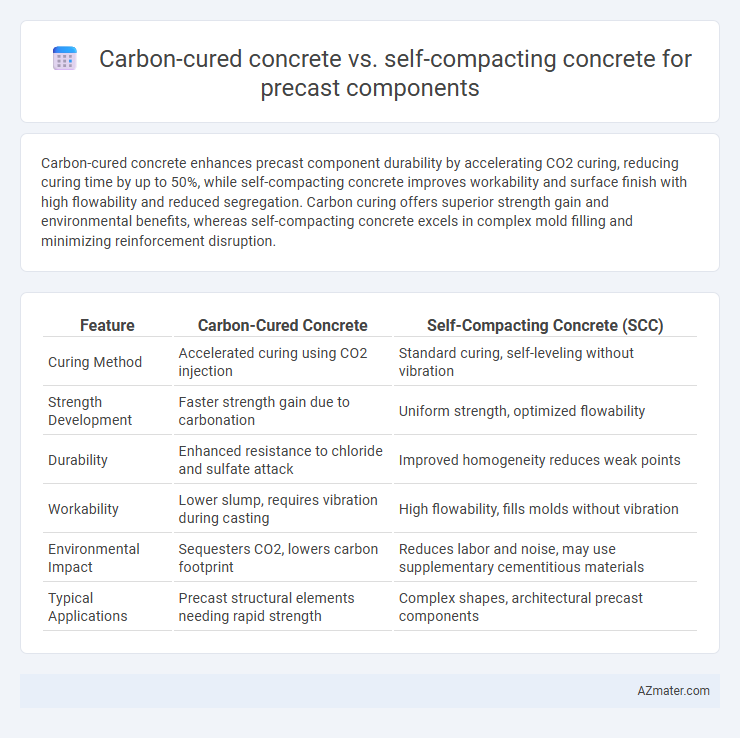Carbon-cured concrete enhances precast component durability by accelerating CO2 curing, reducing curing time by up to 50%, while self-compacting concrete improves workability and surface finish with high flowability and reduced segregation. Carbon curing offers superior strength gain and environmental benefits, whereas self-compacting concrete excels in complex mold filling and minimizing reinforcement disruption.
Table of Comparison
| Feature | Carbon-Cured Concrete | Self-Compacting Concrete (SCC) |
|---|---|---|
| Curing Method | Accelerated curing using CO2 injection | Standard curing, self-leveling without vibration |
| Strength Development | Faster strength gain due to carbonation | Uniform strength, optimized flowability |
| Durability | Enhanced resistance to chloride and sulfate attack | Improved homogeneity reduces weak points |
| Workability | Lower slump, requires vibration during casting | High flowability, fills molds without vibration |
| Environmental Impact | Sequesters CO2, lowers carbon footprint | Reduces labor and noise, may use supplementary cementitious materials |
| Typical Applications | Precast structural elements needing rapid strength | Complex shapes, architectural precast components |
Introduction to Precast Concrete Components
Precast concrete components are essential in modern construction, offering enhanced quality control, rapid installation, and reduced site labor. Carbon-cured concrete improves precast elements by using CO2 for curing, which accelerates strength gain and reduces carbon footprint, while self-compacting concrete enhances precast quality through its high flowability and ability to fill intricate molds without vibration. Both technologies optimize precast concrete performance but target different production efficiencies and environmental benefits.
Overview of Carbon-Cured Concrete
Carbon-cured concrete utilizes carbon dioxide in its curing process to enhance strength and reduce curing time, making it an eco-friendly alternative in precast component production. The carbonation process improves durability and reduces the carbon footprint by permanently sequestering CO2 within the concrete matrix. This technology contrasts with self-compacting concrete, which relies on flowability to eliminate vibration during casting but does not inherently capture carbon.
Understanding Self-Compacting Concrete
Self-compacting concrete (SCC) offers superior flowability and filling ability without the need for mechanical vibration, making it ideal for complex precast components with intricate molds and dense reinforcement. Its high fluidity ensures uniform compaction and reduced labor costs compared to traditional carbon-cured concrete, which primarily focuses on accelerating strength gain through carbon dioxide curing. SCC's optimized mix design enhances durability and surface finish quality, crucial for precast elements exposed to structural and aesthetic demands.
Comparative Material Properties
Carbon-cured concrete exhibits enhanced compressive strength and improved durability due to accelerated carbonation, making it ideal for precast components requiring rapid strength gain and reduced permeability. Self-compacting concrete offers superior flowability and uniformity without mechanical vibration, optimizing surface finish and reducing labor in complex mold geometries. Comparative analysis shows carbon-cured concrete excels in early age performance and environmental impact reduction, while self-compacting concrete ensures better workability and dimensional tolerance for intricate precast elements.
Environmental Impact Assessment
Carbon-cured concrete significantly reduces carbon emissions by capturing and storing CO2 during the curing process, enhancing the sustainability of precast components. Self-compacting concrete improves workability and reduces the need for mechanical vibration, decreasing energy consumption and noise pollution on-site. Evaluating both materials through an Environmental Impact Assessment highlights carbon-cured concrete's potential for carbon sequestration, while self-compacting concrete excels in reducing operational environmental impacts during manufacturing and installation.
Cost Efficiency and Lifecycle Analysis
Carbon-cured concrete offers significant cost efficiency in precast components by reducing curing time and energy consumption through accelerated carbon dioxide curing methods, leading to lower operational expenses compared to traditional curing techniques used in self-compacting concrete (SCC). Lifecycle analysis reveals that carbon-cured concrete can reduce carbon emissions by sequestering CO2 during curing, contributing to sustainable construction, whereas SCC provides enhanced durability and reduced maintenance costs due to its high flowability and homogenous microstructure. Evaluating total cost of ownership, carbon-cured concrete shows advantages in upfront production speed and environmental impact, while SCC excels in long-term performance and minimal repair requirements.
Performance in Structural Applications
Carbon-cured concrete enhances durability and strength through accelerated carbonation, resulting in improved compressive strength and reduced permeability critical for precast structural components. Self-compacting concrete offers superior flowability and uniformity without segregation, ensuring high-quality finishes and consistent mechanical performance in complex precast elements. For structural applications, carbon-cured concrete provides enhanced long-term durability, while self-compacting concrete excels in achieving intricate shapes with minimal defects and reliable load-bearing capacity.
Production and Curing Processes
Carbon-cured concrete utilizes CO2 injection during the curing process to accelerate strength gain and reduce carbon footprint, making it efficient for precast components with rapid production cycles. Self-compacting concrete (SCC) flows under its own weight without mechanical vibration, enabling precise casting and smooth surface finishes in complex molds often used in precast manufacturing. While carbon curing shortens overall curing time through chemical carbonation, SCC emphasizes workability and uniformity during placement, optimizing quality control in precast production.
Durability and Maintenance Considerations
Carbon-cured concrete enhances durability through accelerated carbonation, which reduces porosity and increases resistance to chloride-induced corrosion, making it ideal for precast components exposed to harsh environments. Self-compacting concrete offers superior homogeneity and void-free compaction, minimizing micro-cracks and thus lowering maintenance frequency due to improved resistance to freeze-thaw cycles and mechanical wear. Both technologies optimize long-term performance, but carbon-curing specifically targets chemical durability, while self-compacting concrete focuses on structural integrity and ease of casting.
Future Trends and Recommendations
Carbon-cured concrete enhances sustainability by accelerating CO2 absorption during curing, reducing carbon footprint in precast components, while self-compacting concrete improves productivity with superior flowability and reduced labor requirements. Future trends indicate integration of carbon capture technologies with self-compacting mixes to optimize both environmental impact and construction efficiency. Recommendations emphasize adopting hybrid approaches combining carbon curing with advanced admixtures and automation to meet stringent durability standards and carbon neutrality goals in precast manufacturing.

Infographic: Carbon-cured concrete vs Self-compacting concrete for Precast component
 azmater.com
azmater.com